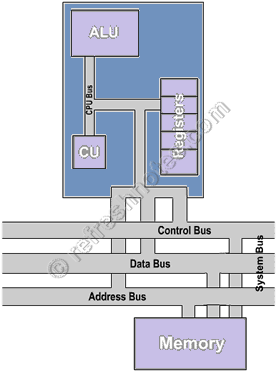What is a Microprocessor?
A microprocessor (µP) is a computer processor that incorporates the functions of a computer's central processing unit (CPU) on a single integrated circuit (IC), or at most a few integrated circuits.
The simplified model of microprocessor consists of,
Control Unit: Consists of Instruction Fetch Unit, Instruction Decoder, Clock module, Control Logic Circuits
Arithmetic and Logic Unit: Execute Arithmetic and Logical operations. It works with register array to perform
Register Array: Group of registers. Commonly,
System Bus: Comprised of control bus, data bus, address bus, Connects Processor with memory and peripherals, Transfer data across system
The simplified model of microprocessor consists of,
Control Unit: Consists of Instruction Fetch Unit, Instruction Decoder, Clock module, Control Logic Circuits
- Fetch Unit – Fetch program instruction from memory
- Decoder – Decode the instruction fetched from memory
- Clock – Generate and Control Clock signals for synchronization
- Control Circuits – Generate control signals
- Controls the operation of ALU
Arithmetic and Logic Unit: Execute Arithmetic and Logical operations. It works with register array to perform
- Addition – Using adders (Half adders and Full adders)
- Subtraction – Using Inverters and Two’s complement arithmetic
- Multiplication and Division – Using Math’s co-processor or special floating point hardware
- Logical tests – Using logic gates
- Comparison – Using logic gates
- Bit Shifting – Using shift register
- Boolean Operations – Using logic gates
Register Array: Group of registers. Commonly,
- Program Counter (PC) – Holds memory address of the next instruction that has to be executed in a program
- Instruction Register (IR) – Hold the current instruction in the processor while it is being decoded and executed
- Accumulator (A or ACC) – Holds the result of operations performed by ALU
- Memory Address Register (MAR) – Holds memory addresses involved in the instructions held in instruction register
- Memory Data or Buffer Register (MDR or MBR) – Holds data fetched from memory address or data to be written in memory address
- Flag Register/Status Flags/Condition code register – Contains the current state of the processor. It is a collection of status flag bits of a processor. Zero Flag, Carry Flag, Negative Flag, Overflow Flag
- Stack Pointer (SP) – Holds top of the stack memory
- General Purpose Registers – Used to hold operands of an instruction
System Bus: Comprised of control bus, data bus, address bus, Connects Processor with memory and peripherals, Transfer data across system
- Control Bus – carries the signals relating to the control and co-ordination of the various activities
- Data Bus – a bi-directional bus used to exchange of data between the processor, memory and peripherals
- Address Bus – connections between the microprocessor and memory which carry the address from/to which the CPU wishes to read or write. The number of bits or lines of address bus determines the maximum size (2bits or lines) of memory which the processor can access. 24 = 16 bytes
28 = 256 bytes
216 = 65536 bytes = 64 KB
224 = 16777216 bytes = 16 MB
232 = 4294967296 bytes = 4 GB
264 = 18446744073709551616 bytes = 17,179,869,184 GB
Related topics:
Computer Internals | Microcontroller | Microprocessor Vs Microcontroller | Microcontroller and Embedded Systems | Choosing a Microcontroller
List of topics: Microcomputer

No comments:
Post a Comment